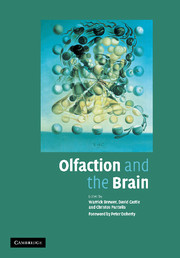Book contents
- Frontmatter
- Contents
- Foreword
- Preface
- List of Contributors
- Section I Neurology, Neurophysiology and Neuropsychology: Olfactory Clues to Brain Development and Disorder
- Section II Social Functioning: Role of Evolution, Genetics and Gender
- Section III Assessment and Disorders of Olfaction
- 13 Assessment of Olfaction
- 14 Olfactory Impairment in Neuropsychiatric Disorders
- 15 Olfaction in Parkinsonian Syndromes
- 16 Olfaction in Psychosis
- 17 Olfactory Hallucinations
- 18 Delusions of Body Malodour: The Olfactory Reference Syndrome
- Index
- Plate section
- References
17 - Olfactory Hallucinations
from Section III - Assessment and Disorders of Olfaction
Published online by Cambridge University Press: 17 August 2009
- Frontmatter
- Contents
- Foreword
- Preface
- List of Contributors
- Section I Neurology, Neurophysiology and Neuropsychology: Olfactory Clues to Brain Development and Disorder
- Section II Social Functioning: Role of Evolution, Genetics and Gender
- Section III Assessment and Disorders of Olfaction
- 13 Assessment of Olfaction
- 14 Olfactory Impairment in Neuropsychiatric Disorders
- 15 Olfaction in Parkinsonian Syndromes
- 16 Olfaction in Psychosis
- 17 Olfactory Hallucinations
- 18 Delusions of Body Malodour: The Olfactory Reference Syndrome
- Index
- Plate section
- References
Summary
Introduction
Traditional teaching in psychiatry has been that until proven otherwise the presence of olfactory, gustatory and visual hallucinations is a marker of underlying organic pathology. Visual hallucinations are seen in delirium or Lewy body disease, while olfactory and gustatory hallucinations raise the possibility of medial temporal pathology, especially epilepsy. The aims of this chapter are first to review the literature on olfactory hallucinations and second to discern any characteristics of olfactory hallucinations which allow those of organic aetiology to be distinguished from those of functional origin, such as those related to schizophrenia.
The subjective experience of olfactory phenomena in the absence of a stimulus has been generally referred to as an olfactory hallucination, though when experienced in the context of epilepsy the term olfactory aura has been preferred. In addition, other terms used to describe the same phenomenon have included olfactory reference syndrome, experiential hallucinations, and experiential responses. Each of these terms will be used in the course of this review and their origins explained. The available literature is replete with case series, case reports, highly selected populations and widely differing methods of assessment. While this limits the comparisons between studies, it is still possible to estimate the prevalence and nature of the olfactory hallucinations in many of the studies.
Epilepsy and olfactory auras
Numerous studies have examined groups of patients with regard to the presence and characteristics of olfactory hallucinations but there has been no attempt to standardise the descriptions across different studies, an understandably difficult task.
Keywords
- Type
- Chapter
- Information
- Olfaction and the Brain , pp. 322 - 333Publisher: Cambridge University PressPrint publication year: 2006
References
- 4
- Cited by



